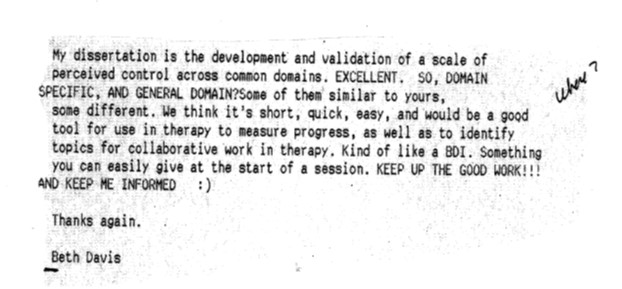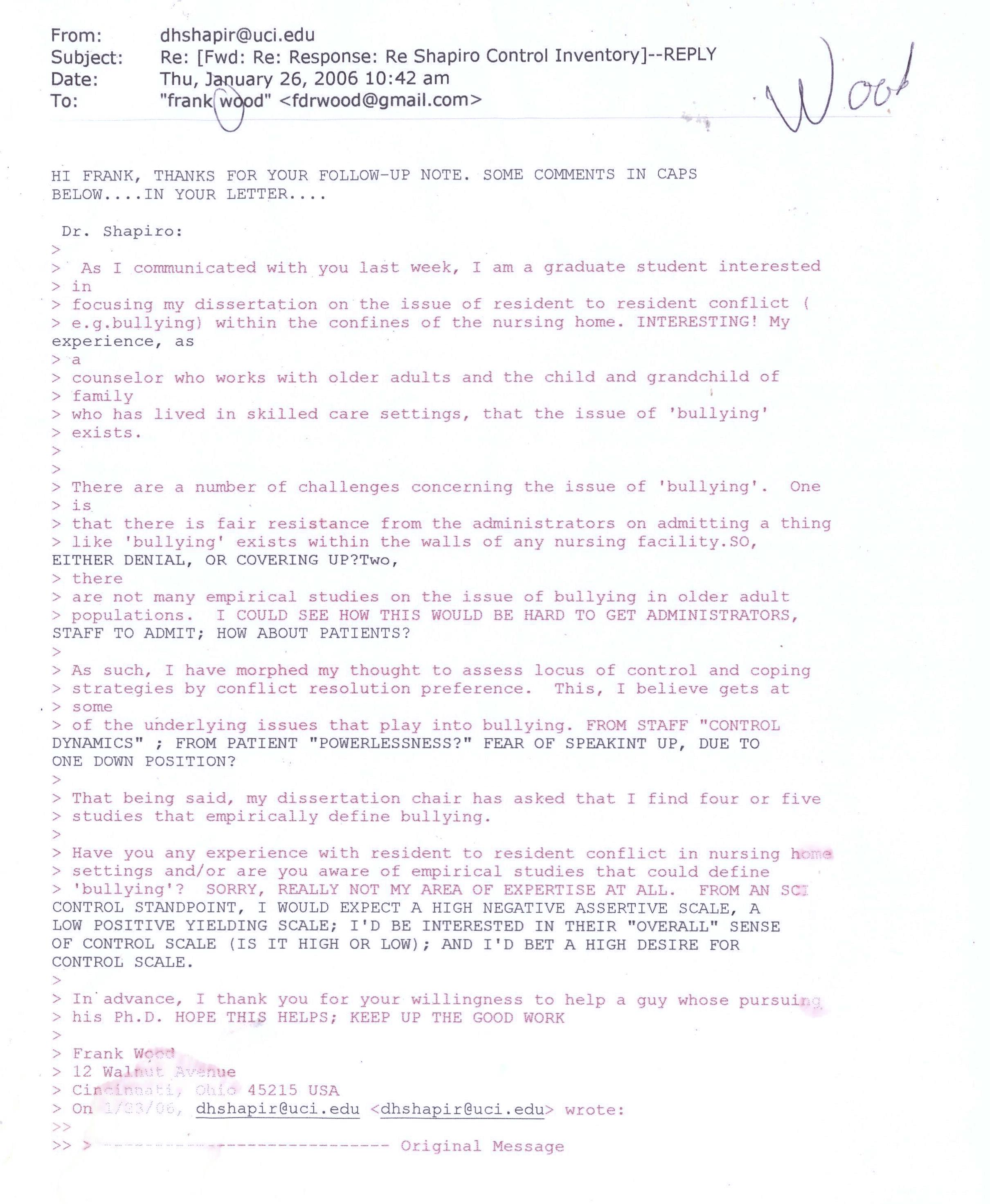Below is a list of articles related to Control Therapy, Sense of Control, and the SCI. They provide an opportunity for the reader to peruse the range of writing that has been done related to these topics.
The SCI has been adapted to different languages and has been applied in different countries related to multiple topics. For a listing of topics, languages and countries, please click here.
p. 3 The Shapiro Control Inventory, hereafter SCI (Shapiro, 1994) provides a multidimensional profile on the psychological construct of control. To this end, it provides information on what is the specific problem of the person related with control, identifies what style of control should be used to deal with the problem, and defines where specific deficits on control exist. This information helps to focus control-related aspects to which a psychotherapeutic intervention should be directed. (Shapiro and Astin l998; Shapiro, Shapiro, D, Soucar, B., Shapiro, S.L, Astin, 2009. In recent years SCI has been adapted to different languages and has been applied in different countries and contexts with the purpose of analyzing problems related to eating behavior disorders in Hong Kong, New Zealand and Jerusalem (Sing, Chang, Kwok & Hsu, 2004; Surgenor, Horn & Hudson, 2003), the consumption of alcohol in New Zealand and the United Kingdom (Sepehri & Miles, 2010; Surgenor, Horn, Hudson, Adamson & Robertson, 2006), breast cancer in Arizona (Shapiro, Figuerero, Caspi, Schwartz, Bootzin, Lopez & Lake, 2002), cultural differences between the Chinese and American population (Chia Cheng & Chuang, 1998), the prison population in Spain (Santibáñez, 1994), anxiety disorders in Argentina (Bogiaizian, 2004) and professionals in the field of public health (Shapiro, Astin, Shapiro, Robitshek & Shapiro, 2011).
* * * * *
Additional articles by Dr. Shapiro and colleagues can be found in Additional Articles under 'What is Control Therapy.
GAINING A POSITIVE SENSE OF CONTROL:Teaching the Principles and Practice of Control Therapy in an Educational Setting (PDF file) — 2012 class (This article was based on the Senior Independent Study of Justine Kruse. Published 2019)
a. Student comments/essays on what they got out of classes
In class writing: modes, politics, religion
A student’s comments/concerns, and my response.
— Click here For Johanna’s comment on above.
b. 2003 Class on Gaining a Positive Sense of Control
— Additional student comments/essays on what they got out of the 2003 class.
c. A Consent Form model for teaching a Class on "Gaining a Positive Sense of Control"
Soucar, Beth, Establishing Culturally Competent Practice: Effects of Control-Enhancing Psychotherapy on Depression and Anxiety for African American Outpatients
Multicultural competent control therapy: An Example with Therapist/Client dialogue
Data Analysis and Hypotheses; This section (excerpted) presents the four research questions and the hypotheses the flow from them. It also describes the research setting.
Training of Therapists and Treatment Model; Therapist Adherence Checklist - Soucar, Beth
General Goals of Control Therapy
Training Objectives; An overview of the Twelve Sessions; Flow Chart for a Control Therapy Research Project
As you read through the 12 sessions, if you want to pause and gain more information please feel free to click on one of the following at the appropriate time.
Control Inventory: Background and Description (Utilized in one of the early sessions)
Four Modes of Control (after the second or third session)
Five Steps for Gaining Control in Each mode (after the second or third session)
Maintaining Treatment Integrity; Monitoring Participant Adherence; Participant Incentives
Data Collection (assessment instruments and timing); results; (excerpts) Soucar, Beth
Consent Forms and Permission to Videotape
Initial Control Research Foundation Feedback
Initial discussions including formation of a Control Research Foundation
Leila Azizi ABSTRACT. The impact of Control Therapy on heart rate variability (HRV) and reduced premenstrual syndrome. Iran.
Women in the free choice group report greater positive sense of control compared to the MSRB group, Shapiro, Shauna
Rediscovering and Reapplying Contingent Informal Meditation (PDF file) Joseph TLOCZYNSKI, Amy MALINOWSKI and Robert LAMORTE, Bloomsburg University. U.S.A.
Control overestimation in anxiety disorders: Paper presented at the Anxiety Disorders Association of America 2015, Daniel Bogiaizian, PhD
Perceived control and self control in four clinical populations, Bo Brown, M.D. (PDF file)
Meditation and Daily Living: Effect on cognitive style, Awareness, affect, and acceptance (PDF file) Easterline, B.L. (edited dissertation excerpts): Meditation and Daily Living: Effect on cognitive style, Awareness, affect, and acceptance. (acceptance and sense of control in short and long term meditators).
An eight-week program in stress-reduction based on training in mindfulness meditation: Effects on psychological symptomatology, sense of control, and spiritual experiences (PDF file) John Astin, M.A. Department of Psychology & Social Behavior University of California, Irvine, Meditation and sense of control, (1997) Psychotherapy and Psychosomatics, 66(2), 97-106.
Self-management of hyperactivity: Children's use of jogging (PDF file) Elsom, S. D. (1981). Self-management of hyperactivity: Children's use of jogging. (Doctoral dissertation, Pacific Graduate School of Psychology, 1980). Dissertation Abstracts International, 41, 3176B.
The Paradox of Self-Control (PDF file) Hendlin, S, “the Paradox of self-control. In The Disciplined Online Investor (New York, McGraw Hill, 2000).
The Pychology Construct of "Control": A Third Generation Assessment Approach (PDF file) Robert A. Broenen, Psy.D July 14-18, 1992.
Creativity and Control (PDF file) Robert A. Broenen, Psy.D Paper presented at the International Council of Psychologists, 50th annual convention, Amsterdam, The Netherlands, July 17, 1992.
Self-Control & Prisoners (overview) Rosa Santibanez
Self-Control in Prisoners/Normal (Statistical analysis) Rosa Santibanez
A Cross-Sectional Study Of The Effects Of Holotropic Breathwork: Quantitative And Qualitative Findings Kirsten Enriquez
The Practice of Gratitude, Jim McQuade, MD. Relationship of gratitude to internal and external locus of control, limits of gratitude, practice of gratitude, relationship to "personality theory"
The Vitality Connection, Michael Grossman, M.D. and Jodi Jones, Ph.D.,( Excerpt on stress management and using the positive assertive (mastery) and yielding/accepting) modes of control.
SCI: Adaptation into Spanish and psychometric study in women who are victims of gender-based violence, Iraurgi, I, Galego, V., Santibañez, R, Shapiro, D.,( University of Deusto (Spain) Personality and Individual Differences (JCR: 1.877), 2017
Galego, V. (2015) Personal autonomy and coping in women in situations of abuse (published by the General Directorate for Gender Violence of the Government of Spain). Galego, V. (2015). Autonomía personal y afrontamiento en mujeres en situación de maltrato. Ministerio de Sanidad, Política Social e Igualdad: Madrid. En View Publishing site
Galego, V. (2014). El binomio agente-objeto de control desde la perspectiva de la mujer en situación de maltrato. En Libro de Resúmenes: I Congreso de la Sociedad Científica Española de Psicología Social y XII Congreso Nacional de Psicología Social (112-114). Sevilla: SCEPSP. the binomial agent-object of control carried out with abused women through a qualitative study where I asked them what is for them the feeling of control and how they perceived the sensation of control before, during and after the experience of abuse.
Galego, V., Iraurgi, I. y Santibáñez, R. (2014). Percepción de control en mujeres víctimas de la violencia de género: Una clave para el empoderamiento. En Silvestre, M., Royo, R y Escudero, E. (eds.). En Empoderamiento de las mujeres como estrategia de intervención social (429-440). Bilbao: Deusto Digital.
Vanesa Galego Carrillo, Ioseba Iraurgi Castillo y Rosa Santibáñez Gruber Percepción de control en mujeres víctimas de la violencia de género: una clave para el empoderamiento.
Gender Violence and Self-Control: Adaptation and Validation of the SCI in Spanish, Carrillo, Galego Vanessa Abstract
Santibañez, R., Galego, V. and Iraurgi, I. (2018). Sense of control in women who are victims of gender-based violence measured by Shapiro Control Inventory. In Gender Issues in Latin America and Spain. Multidisciplinary Perspectives. Peter Lang: New York. (In press)
Establishing Culturally Competent Practice: Effects of Control-Enhancing Psychotherapy on Depression and Anxiety for African American Outpatients, Soucar, Elizabeth Ann, Doctor of Philosophy Additional Reading
Schwartz, Weissberg-Benchell, and Perlmuter Personal Control and Disordered Eating in Female Adolescents With Type 1 Diabetes.
Eating disorders across two cultures: does the expression of psychological control vary?, Nerissa Soh, Lois J. Surgenor, Stephen Touyz & Garry Walter Abstract
Initial Control Research Foundation Feedback
Paul E. Jose & Kirsty F. Weir Adolescent Sense of Control: A Downward Extension of the Shapiro Control Inventory to Pre- and Early Adolescents. The Journal of Genetic Psychology Research and Theory on Human Development, Volume 174, 2013 - Issue 5, Pages: 494-513.
Initial Control Research Foundation Feedback
Relationship of desire for control and positive yielding mode to trust, Christie, Anne Abstract
Initial Control Research Foundation Feedback
Abstract
PURPOSE:
Identifying psychological strategies to buffer the adverse outcomes in people with diabetes mellitus (DM) remains a priority for many health professionals. While 'locus of control' (LOC) has been repeatedly investigated to this end, research findings are contradictory. The development of more complex appraisals of psychological control, and the utilization of control inventories deriving from such analyses, presents a way forward from such contradictions.
METHODS:
Employing such a measure, this study examines the relationship between metabolic control and psychological sense of control in 96 women with DM.
RESULTS:
Optimal metabolic control is significantly associated with overall sense of control, while poor metabolic control was significantly associated with experiences of loss of psychological control and feelings of inadequacy. Furthermore, poor metabolic control was significantly associated with reduced control in the specific domains of interpersonal relationships and bodily functions.
CONCLUSIONS:
Multidimensional control inventories enable a more complex appraisal of the relationship between metabolic control and psychological control, and in doing so, provide a way forward from problems arising from reliance on LOC constructs. Interventions for DM management relying on aspects of psychological control need to target domains beyond traditional issues of self and bodily functions.
Further Iterations of the Integrated Mindfulness Model (IMM), Gerza, JJ
A Control Theory Perspective on Attrition in Military Training (Abstract), Yannopoulos, M.
Lois J. Surgenor, Jacqueline Horn, Elizabeth W. Plumridge, Stephen M. Hudson Anorexia nervosa and psychological control: a reexamination of selected theoretical accounts.
Sing Lee, Y.Y. Lydia Chan,Kathleen Kwok, L.K. George Hsu Relationship between control and the intermediate term outcome of anorexia nervosa in Hong Kong. Australian, New Zealand Journal Of Psychiatry, 2005, March 39(3) 141-145
Summer W Nipomick, Psychological sense of control and recovery from anorexia nervosa Fielding Graduate University, Doctoral dissertation Santa Barbara, CA. Paper presentation at the 2013 International Conference on Eating Disorders, Montreal, Canada, 05-2013.
Full Disertation can be ordered here.
Additional comments/dialogue on the study
Mei-Rong Liu, Sue-Hwang Chang A Comparison of Attitudes toward Life and Death, Experiential Avoidance, and Sense of Control among Self-Mutilative Adolescents with and without Borderline Personality Traits Formosa Journal of Mental Health, 24(3), 429-455.
Mei-rong Liu, Sue-Hwang Chang Assessing a Multidimensional Construct of Human Control: The Psychometric Properties of the Chinese Version of the Shapiro Control Inventory.
Sense of control, stress reactivity and recovery in women. Read more: Note, this article was sent for review by the Journal Stress and Anxiety to Dr.S, who had retired. Here is the abstract. If you are the author or know the author, please contact the website administrator! Thanks =)
Paschane (apaschan@utah.gov; control and psychophysiology lab in Seattle (positive and negative sense of control scales. woman's health research; examining stress reactivity and personal sense of control: those with healthy sense of control will have lower cardiovascular stress reactivity (BP,HR, vagal tone) amypaschane@yahoo.com.
Diane L Rosenbaum, Kamila S White, Ernest V Gervino The impact of perceived stress and perceived control on anxiety and mood disorders in non-cardiac chest pain. Journal of Health Psychology First Published February 7, 2012 Research Article
Meigan K. Ragg Locus of control in chronic fatigue syndrome : Does it matter?.
Surgenor LJ1, Horn J, Hudson SM. Links between psychological sense of control and disturbed eating behavior in women with diabetes mellitus. Implications for predictors of metabolic control. J Psychosom Res. 2002 Mar;52(3):121-8.
Surgenor, Lois J.; Horn, Jacqueline; Hudson, Stephen M.; Adamson, Simon; Robertson, Paul Alcohol Dependence and Psychological Sense of Control: Refining the Links. New Zealand Journal of Psychology Vol. 35, No. 3, Nov. 2006
Fierro, Rita, Area of Study: Sense of control, agency of control in black women going from welfare to work. Initial Control Research Foundation Feedback.
Fierro, Rita, African American Agency Within Welfare Agencies: A critical study of African American mothers with transitional custody. (Material on the SCI and control in particular can be found on pages 68-69; 209-213; 219-220)
Gaher, Raluca, Area of Study: Control and substance abuse in college students. Initial Control Research Foundation Feedback.
Tonczyczyn, Heather, "Level of distress and perception of control in concerned significant others of substance abusers" (2006). Theses and Dissertations. 941. https://rdw.rowan.edu/etd/941.
Davis, Beth Arburn, "Development and Validation of a Scale of Perceived Control Across Multiple Domains" (2004). PCOM Psychology Dissertations. Paper 37. View Dissertation....


Wood, Frank, Bullying within nursing homes; Prevalence and Consequences to Psychological Health, Walden University 2007 SBN, 05490699769780549069973

Frye, Christina, Eating Patterns and Control Issues among Adolescent Females
Chia, R.C, ,Cheng, B.S.,and Chuang, C.J., (1998), Differentiation in the source of internal control for Chinese. Journal of Social Behavior and Personality 13(4),565-578
Sung, SY & Park, SH (2008). Validation of the Korean version of Shapiro control inventory. Korean Journal of Social and Personality Psychology, 22(4), 111-132.
An excellent paper on self-change: Analysis of the Concept of Unassertiveness
Robyn Catagnus: Single‑Subject Design Studies of Mindfulness Interventions for Behavior Change: A Scoping Review and Behavioral Conceptualization
Diane E. Nash-Mc Feron: "A dissertation submitted in partial fulfillment of the requirements for the degree of Doctor of Philosophy in Clinical Psychology." Thesis (Ed. D.)--Seattle Pacific University, 2006. Includes bibliographical references (leaves 99-109). Mindfulness training resulted in improvement of quality of life and sense of control but not in the reduction of perceived pain.
Sense of Control Predicts Depressive and Anxious Symptoms Across the Transition to Parenthood
Courtney Pierce Keeton, Maureen Perry-Jenkins, and Aline G. Sayer
https://www.ncbi.nlm.nih.gov/pmc/articles/PMC2834184/
J Fam Psychol. Author manuscript; available in PMC 2010 Mar 8.
Published in final edited form as:J Fam Psychol. 2008 Apr; 22(2): 212–221.doi: 10.1037/0893-3200.22.2.212; PMCID: PMC2834184NIHMSID: NIHMS171654 PMID: 18410208
SCI· Analisis De La Version Espanola Del Instrumento "Shapiro Control Inventory" (PDF file) Rosa Santibanez
SCI· I. General Domain Sense of Control (PDF file)
SCI· II. Domain Specific Sense of Control (PDF file)
SCI· III. Four Modes - Supplimental (PDF file)
SCI· Part Three - Translation to Spanish (PDF file) (including agreement among specialists) Rosa Santibanez
SCI· Part Three - Translation to Spanish continued (PDF file) (including factor analysis) Rosa Santibanez
Diagnostico De Los Cuatro Cuadrantes De Autocontrol (PDF file) Rosa Santibanez - For the SCI and the Shapiro Control Content Analysis Scales: the Four Quadrants/Modes
Marco Teorico: Modelo De Autocontrol De Los Cuatro Cuadrantes (PDF file) - Rosa Santibanez - Theoretical Model of Control
Results with the Self·Control Variable: Prisoners Rosa Santibanez
Comments on the Spanish Translation of the SCI - Bob Stenberg.
Comments on the Spanish Translation of the SCI - Rosa Santibáñez.
Zenvagen (PDF file) - Self-control, control by a benevolent other, and meditation: Is God a confounding variable in meditation research? In MGT Kwee (Ed.)Psychotherapy, Meditation, and Health London/Hague: East--West Publications, 1990, 65-123.
Translation: Swedish (H. Karllson). Part One In Zenvagen,46, 13-27, 1991; Part Two in Zenvagen 47,10-15, 1991.
SCI: Chinese Translation Scales 1 and 9.
Complete SCI: Chinese Translation.
Revising of the Shapiro Control Inventory and It's Relation to Self-Esteem, Anxiety, Depression - Shin Zili.
NOTE: Many of the Chinese characters did not translate and thus show as boxes
NOTE: This is the version currently available on the SCI testing website.
Liu, M. R., & Chang, S. H. (2013). A comparison of attitudes toward life and death, experiential avoidance, and sense of control among self-mutilative adolescents with and without borderline personality traits. Formosa Journal of Mental Health, 24(3), 429-455.
SUPPLMENTAL MATERIAL CHINESE (SIMPLIFIED CHARACTER) - Shenzili
Chia, R.C, ,Cheng, B.S.,and Chuang, C.J., (1998), Differentiation in the source of internal control for Chinese. Journal of Social Behavior and Personality 13(4),565-578
Read further correspondence with: Drs. Chia, Sinziili, Mei-Rong.
Read a note on Simplified Chinese Characters.
SCI: Korean Version of the Shapiro Control Inventory: Sung Hyun Park and Dr. Seoung yun Sung, The article was published in Journal of Korean Psychological Association: Society & Personality in 2008.
Sung, SY & Park, SH (2008). Validation of the Korean version of Shapiro control inventory. Korean Journal of Social and Personality Psychology, 22(4), 111-132.
Byoung-bae Min, Comments on Control Therapy.